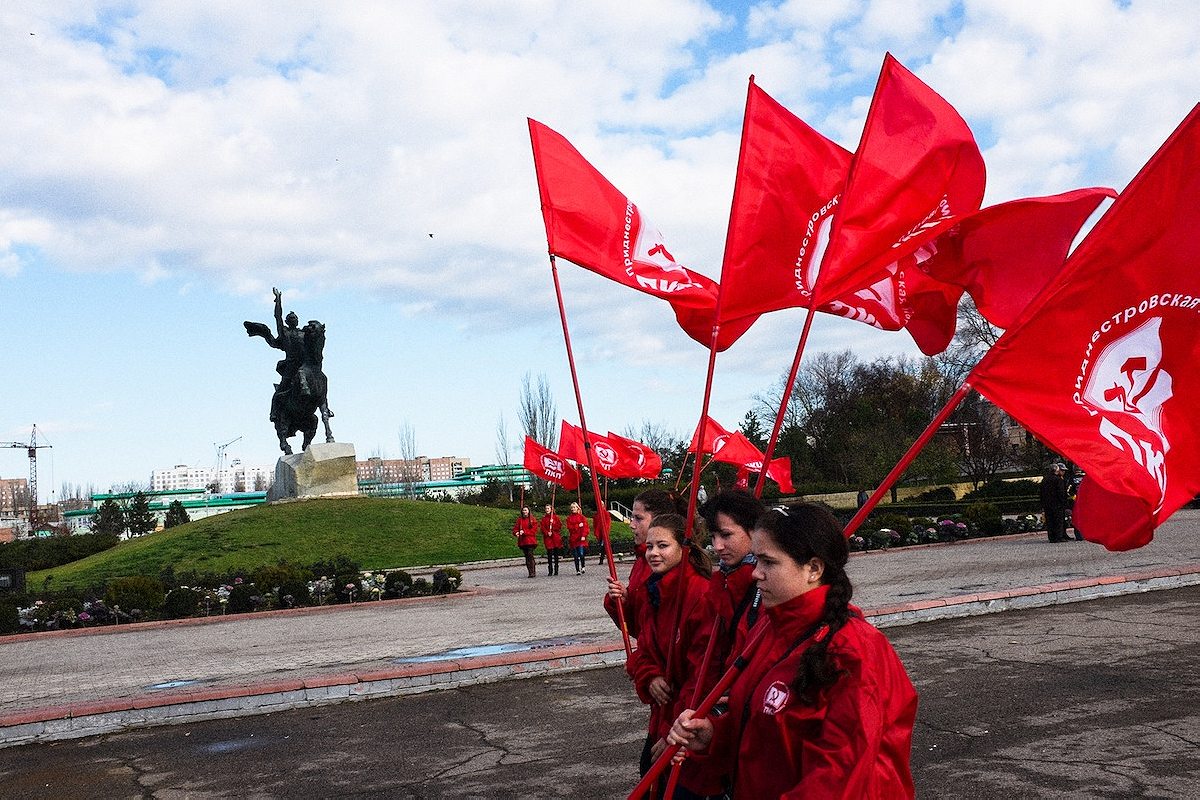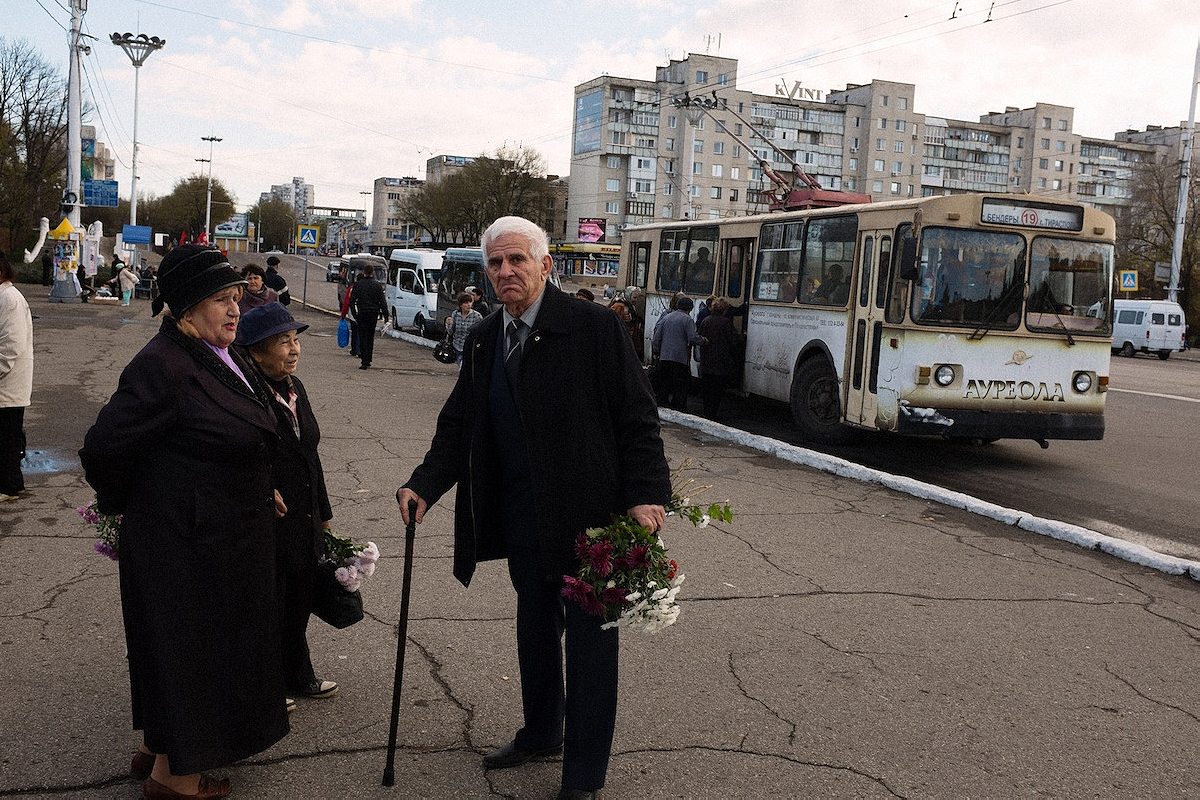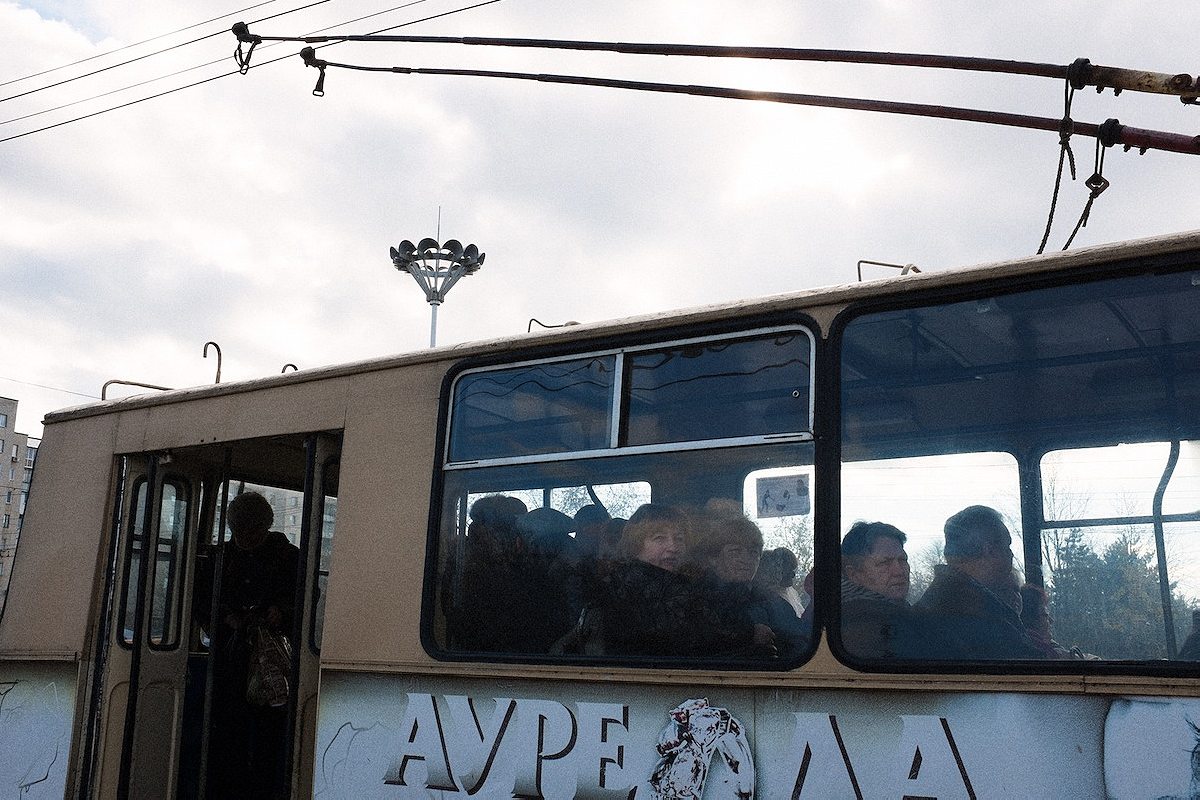For a glimpse of one possible future for eastern Ukraine, look no further than the frozen-in-time breakaway republic of Transnistria.
TIRASPOL, Moldova—
It’s anyone’s guess whether eastern Ukraine will be goaded into separating from the rest of the country, but for a glimpse of what that divorce might look like, you don’t have to look any further than the small pro-Russian breakaway of Transnistria.
That’s where I found myself recently, on an overcrowded minibus making the 80 km (50 mile) trip between the capital of Transnistria and the capital of Moldova, the country it separated from. It passes east-west through the main “border” checkpoint, on the Dniester River, past the fortified bridgehead where an armored personnel carrier is surrounded by Kalashnikov-wielding troops and secret service agents inspect documents.
Among the passengers on the minibus with me are Svetoslav Terescenko, 20, and Tatiana Verejan, 19, for whom this is the route between their home in the east and their university in the west. It’s also a potential path from the past to the future, because although they identify strongly with Russia, they see opportunity in the West.
While speculation continues over whether Russia, following its annexation of Crimea, will push west and absorb this separatist enclave, the couple discusses their long-term escape.
“We have always wanted to leave Transnistria,” Terescenko says, holding his girlfriend’s hand. “The people who stay here are getting their money from the government or stealing it from somewhere. Those who can’t see a future are just leaving.” The two first met 18 months ago on this same bus route.
Like many Transnistrian students their age, they’ve chosen to study in Chisinau so their degrees will be recognized abroad. Degrees from Transnistria’s university in Tiraspol only mean something in Russia.

But looking west for opportunities doesn’t equate with a rejection of Russia, says the pair. Terescenko, a medical student, and Verejan, who studies economics, both think annexation would be the best outcome for Transnistria’s stability and agree with Crimea’s absorption into the Russian Federation.
But this current east-west struggle means little to them in real terms. Cold War rhetoric exists in the realm of geopolitics and newspapers. For those planning their careers, families, and lives, it’s not so much a question of allegiance as a matter of pragmatism.
“Our wish right now is to graduate and go to Australia,” says Terescenko, comfortable in a gray hoodie, jeans, and sporting a scruffy Lincoln beard. “Even if Russia does annex us, the situation won’t be better; it will just stay the same. In Russia it’s good to live in Moscow or St Petersburg. The money Russia gives to Transnistria now will be the same. They would just change the passports, nothing else.”
Verejan leans forward: “We just don’t want to go back there.”
HEADING EAST
A couple of hours before meeting Terescenko and Verejan, I was heading the opposite direction. For almost 23 years, Transnistria has—with the help of about 1,500 permanently stationed Russian troops—maintained a self-governed independence from Moldova, which counts the territory within its borders. It’s a de facto state, unrecognized by any sovereign nation. In normal times it’s referred to as a “frozen conflict.” But as Ukraine descends into crisis, Transnistria’s position as a pro-Russian separatist enclave within the boundaries of an aspiring European Union member has seen that label shift. It’s now a “front line” in the escalating showdown between Russia and the West, say experts. And despite the breakaway state prohibiting foreign reporters it hasn’t accredited, a flurry of datelines has appeared from its capital, Tiraspol.
So, donning a Hawaiian shirt to conceal what little journalistic professionalism I could be accused of having, I decided to follow suit to meet the people living in this symbolic battleground. Amid reports of Russian troops staging military drills in the region, our minibus, a shiny Mercedes Sprinter, set off from Chisinau.
As we completed our Transnistria entry forms en route, my translator, Viorel, gave me some additional tips on the tourist routine: “If they ask, say you’ve come to get some Kvint.”
The internationally exported cognac, “the beverage that gives pleasure,” according to its website, is a source of great pride for Transnistria, although the enclave’s infamy as a trafficking haven for everything from guns and people to cigarettes and frozen foods likely eclipses its reputation for brandy.
After a bumpy 90-minute ride east, we reached the border, a checkpoint and small collection of booths guarded by a handful of Cossack cap-wearing troops with Kalashnikovs slung over their backs.
First at a kiosk, then inside a modest cabin, stony-faced officers maintained a stern silence while flicking through my passport. Without having to mention cognac once, I was given the all clear and headed back to the bus.
TIRASPOL
Much has been written about the time-warp aesthetic of Transnistria, which served as the industrialized region of Soviet-era Moldova, although driving through it is more a case of back-and-forth time-traveling—a simple turn of the head can add or subtract 40 years. At one moment you’re staring at old Russian-made Ladas parked outside a dreary apartment block backdropped by a sprawling factory, the next a flashy Mercedes passes by, or you catch a glimpse of the Sheriff Stadium, a massive modern football arena built by (and named after) the region’s biggest company, whose name is plastered on gas stations and billboards.

But despite the sporadic additions of modernity, one travel guide’s description of the republic as “an open air Soviet museum” rings particularly true when we reach October 25th Street, Tiraspol’s main road and a reference to the Russian revolution.
Fronted by a Lenin statue several meters high and topped by a flag bearing the hammer and sickle, Transnistria’s parliamentary building looks every bit as communist as the name of its legislature—still the Supreme Soviet, which has governed the region as the Pridnestrovian Moldavian Republic since it declared independence in 1990 as the Soviet empire crumbled.
Across the road, soldier statues flank a war memorial inscribed with the names of the Transnistrian troops who died in the country’s war against the Moldovan government fought mostly in 1992. Although brief, the conflict claimed about 1,500 lives and only ended when Russian troops and tanks—like the T-34 that has been mounted on a platform as part of the memorial—arrived and backed the separatists.
Since then, the enclave has remained in limbo. Yes, it has adopted a constitution and developed its own military, postal system, currency, and license plates, but not a single United Nations member has recognized it as anything other than a territory within Moldova, statistically Europe’s poorest nation.
Even Russia, whose soldiers never left after the ceasefire and still guard hidden weapon dumps, has refused to recognize its sovereignty, though it’s no secret Russian cash and gas underpins its economy. Pro-EU Moldova sees Transnistria as a threat to national security, while experts around the world are asking whether the enclave could be “the next Crimea.”
THE CAFÉ
About the time I was roaming around Tiraspol’s wide boulevards, NATO’s supreme allied commander in Europe was speaking in Brussels about the threat of a Russian invasion in Transnistria. Putin could use the same “protection of ethnic Russians” pretext, U.S. Air Force Gen. Philip Breedlove told reporters. “There is absolutely sufficient [Russian] force postured on the eastern border of Ukraine to run to Transnistria if the decision was made to do that, and that is very worrisome.” But things looked calm here on this sleepy Sunday, as the few residents outside on the streets dawdled around.
Perhaps the fact that, according to a 2006 referendum, 97 percent of Transnistrians are in favor of joining the Russian Federation might have contributed to the calm.
Despite the worsening situation in Ukraine, the only visible sign of menace was the occasional baton-carrying, camouflage-clad officer patrolling the city. If the secret service—still called the KGB here—were following my activities, they never let on or tried to stop my interviewing Transnistrians. “Don’t worry, we like foreigners here,” said 19-year-old Andrei, a waiter at a modern-ish looking café in the city center. “You’ve got nothing to worry about.”
His hands politely behind his back, Andrei explained that he planned to work in Germany, save money, and open up his own café in Tiraspol.
He was wary about closer ties with the European Union and said annexation by Russia was the best outcome. “We have a Russian soul,” he said.
THE MARKET
The busiest place on a Sunday in Tiraspol is its flea market, held behind a grand statue of the city’s founder, Russian Alexander Suvorov.
Sprawling throughout a grassy park, vendors sell everything from second-hand clothes and pirated CDs to ornamental jewel-encrusted trees, the items spread over blankets on the hard ground. “How is it living here? This is how it is living here” Zinaida Ivanova said wryly, her finger toward her wares—old clothes and a pair of children’s shoes.
The mother of three explains she’d traveled from the nearby city of Bender to sell unwanted goods on the weekend to augment her $200-a-month job as a Romanian language teacher.

Behind her a $100,000 Mercedes sits parked in a row of similarly luxurious cars on Karl Marx Street, another particularly ironic reminder that the privatization of Transnistria’s industry in the 1990s benefited some more than others (most notably Transnistria’s first president, Igor Smirnov). She speaks nostalgically of the Soviet days, when “people had jobs, we had stability, and there were no worries.”
While there’s plenty of pining for the past among Transnistria’s elderly, there are also ethnic, language, and historical divisions that fuel separatist sentiments.
Ethnically speaking, the enclave’s population, officially around 500,000, is mostly split between Moldovans, Russians, and Ukrainians, with a small Bulgarian minority.
Although Moldova is tied to Romania linguistically and has at times been the same country, it has also spent considerable time during the 19th and 20th centuries under Russian influence, first from the Russian Empire then the Soviet Union, resulting in waves of Russification, particularly in the industrialized east. As Moscow’s grip slackened under Gorbachev, Chisinau’s moves toward stronger ties with Romania, its Latin neighbor to the west, upset Russian-speaking groups in Transnistria, leading it to declare independence.
The volatile issue of language differences remains at the heart of the divide, with Romanian schools in Transnistria suffering forced closures and teachers complaining of discrimination.
On top of this, mounds of history and propaganda have piled up. Despite teaching the common language, Ivanova calls the Romanians fascists, a reference to their initial alliance with the Nazis during World War II.
“If we reunited with Moldova, the Romanians would come and push us to wash the floors,” she said. I asked her what she thinks of events in Ukraine. “We feel it’s normal what is happening in Crimea,” she said. “We hope Putin’s plan will come to Transnistria, and we will be united again like the Soviet Union.”
THE RETURN
Although my time in Tiraspol is brief, it’s hard not to sense a certain perpetual paralysis. A place caught between two sides that can’t really fit into either.
Enthusiasm for joining Russia, although strong, is undoubtedly undermined, or at least stymied, by two decades of being overlooked by Moscow. On the flipside, Russian television accentuates and perhaps exaggerates the problems of the European Union, leaving the West an unknown and largely suspicious model.
The frozen status quo benefits a corrupt elite, while the elderly remain nostalgic, and young people leave in search of opportunity and a future.

At least this is the case with Terescenko and Verejan, who hold Moldovan passports and Russian citizenship but have lived most of their life in a place that doesn’t officially exist.
“I think the majority of young people are pro-Russia, but they know there aren’t so many opportunities in Transnistria—the salaries are even less than Moldova,” says Terescenko after we have passed the Transnistrian checkpoint and are safely back in Moldova, leaving behind any fear of being overheard by the wrong people.
“Old people stay, people with jobs in the government stay, and their children stay because they arrange them jobs. Everyone else is going to Chisinau to study.”
I ask whether he thinks Russian annexation would improve the region to the point he’d want to stay or if closer ties to the EU might help.
“We don’t see anything changing. Even if we were united with Moldova, I think the language differences would still cause conflict, while we’re too small to be independent… We don’t think the EU is as democratic as it appears, but we don’t know that much about it, only what we know from TV, which is always showing that it’s in crisis. I haven’t been there to see it with my own eyes,” he said.
The driver abruptly pulls over, and a portly Moldovan border guard climbs on. He begins checking documents while his colleagues search under the bus, another reminder that we’re on a regular smuggling route.
As he finishes inspecting the passports of a group of backpackers, Viorel, my translator, decides to demonstrate his idea of freedom as it exists west of the Dniester by goading the border guard for not saying hello to the passengers.
Visibly frustrated, the officer begrudgingly says a muffled “good day” in English after two minutes of argument. “Can you do this at your border?” says Viorel with a smile.
[Top image: Youthful members of the communist party march on the 96th anniversary of the Russian Revolution. Tiraspol, Moldova. 7 November 2013.]
Davin Ellicson is an American photographer who works between New York City and Bucharest.
